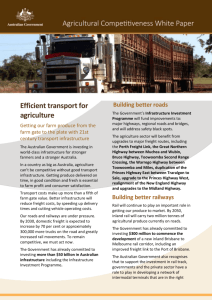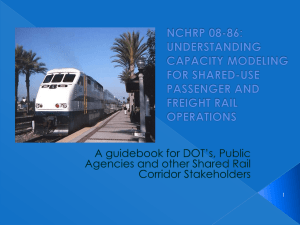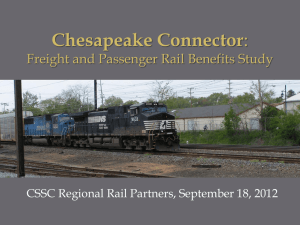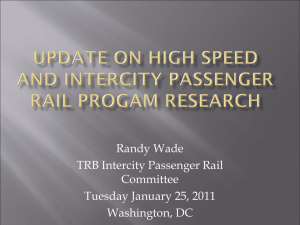Video transcript
advertisement
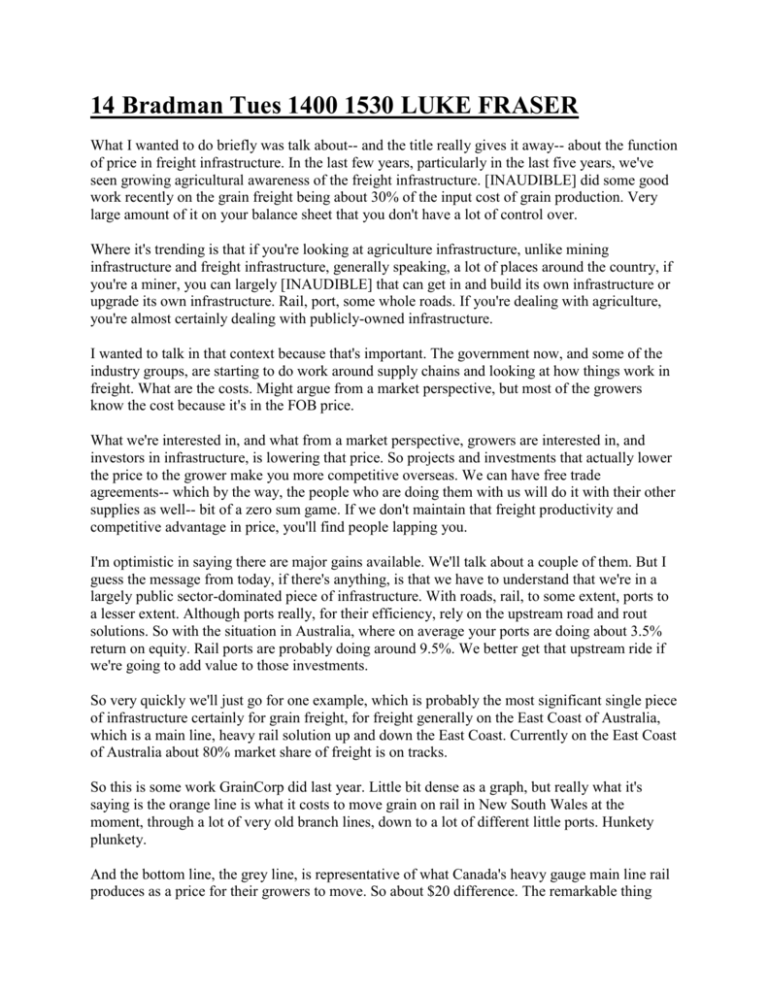
14 Bradman Tues 1400 1530 LUKE FRASER What I wanted to do briefly was talk about-- and the title really gives it away-- about the function of price in freight infrastructure. In the last few years, particularly in the last five years, we've seen growing agricultural awareness of the freight infrastructure. [INAUDIBLE] did some good work recently on the grain freight being about 30% of the input cost of grain production. Very large amount of it on your balance sheet that you don't have a lot of control over. Where it's trending is that if you're looking at agriculture infrastructure, unlike mining infrastructure and freight infrastructure, generally speaking, a lot of places around the country, if you're a miner, you can largely [INAUDIBLE] that can get in and build its own infrastructure or upgrade its own infrastructure. Rail, port, some whole roads. If you're dealing with agriculture, you're almost certainly dealing with publicly-owned infrastructure. I wanted to talk in that context because that's important. The government now, and some of the industry groups, are starting to do work around supply chains and looking at how things work in freight. What are the costs. Might argue from a market perspective, but most of the growers know the cost because it's in the FOB price. What we're interested in, and what from a market perspective, growers are interested in, and investors in infrastructure, is lowering that price. So projects and investments that actually lower the price to the grower make you more competitive overseas. We can have free trade agreements-- which by the way, the people who are doing them with us will do it with their other supplies as well-- bit of a zero sum game. If we don't maintain that freight productivity and competitive advantage in price, you'll find people lapping you. I'm optimistic in saying there are major gains available. We'll talk about a couple of them. But I guess the message from today, if there's anything, is that we have to understand that we're in a largely public sector-dominated piece of infrastructure. With roads, rail, to some extent, ports to a lesser extent. Although ports really, for their efficiency, rely on the upstream road and rout solutions. So with the situation in Australia, where on average your ports are doing about 3.5% return on equity. Rail ports are probably doing around 9.5%. We better get that upstream ride if we're going to add value to those investments. So very quickly we'll just go for one example, which is probably the most significant single piece of infrastructure certainly for grain freight, for freight generally on the East Coast of Australia, which is a main line, heavy rail solution up and down the East Coast. Currently on the East Coast of Australia about 80% market share of freight is on tracks. So this is some work GrainCorp did last year. Little bit dense as a graph, but really what it's saying is the orange line is what it costs to move grain on rail in New South Wales at the moment, through a lot of very old branch lines, down to a lot of different little ports. Hunkety plunkety. And the bottom line, the grey line, is representative of what Canada's heavy gauge main line rail produces as a price for their growers to move. So about $20 difference. The remarkable thing about that is that most of the Canadian grain grows out in the prairies, which are on average probably about 1,000 kilometres longer distance away from their ports than most of the grain that gets grown in Australia. So they're much further away, but they're much more connected in price sense for what they're trying to do. Now a little bit of simple numbers around that. Rather than $20 a tonne, I'm using $16 here to conjure with, because we really can't get today to the axle weights and the heavy rail gauge of Canada very easily. We could get probably, probably I'd argue with $16 per tonne increase with main line East Coast rail. If you take 30 million tonnes, which is how much went out of the ports between South Australia and Brisbane a year or two back. That's looking about a saving about $208 million a year to the grower. If you invested that, with the miracle of compound interest, you'd be somewhere up near $3 billion over ten years. So if you just bear that in mind, you'd be aware at the moment that the current government, which slightly is more sane than the previous government, which was looking at passenger rail all up and down the East Coast, has looked at providing this idea of an inland rail linking Brisbane with the northern reaches of the New South Wales standard gauge rail network. The problem you've got is this. At the moment, the government's allocation to the inland rail build is about $75 million a year for the next few years, the budget. That's for planning and preparatory works. There is no identified white knight financier of that rail build. It's very difficult to get any clear estimate from the government on when that's going to be built. Now, if it's going to take 10 years or more to build, you're looking just for the growers. And bear in mind, the growers on a main line class one rail network are very small fish. But nevertheless, you're looking as a growing community, around nearly $3 billion opportunity cost. Probably fairly more than that, if you add in the reduced maintenance on roads, and probably the efficiencies of scale, you'll get at some of the ports. So what that's drawing you to in price is it's a financing issue, time value of money, and in a public asset, who's allowed to invest. These are really the key things hopefully, we can get across to the farming sector. It's not always the government that's going to solve these solutions. And we need to work around how we bring productive marketing investment into the equation. To give you an alternative very quickly, Kenya, as of last year, concluded a deal to build a similar length of rail between its port-- Bluewater Port at Port Mombasa back to Nairobi, the capital-- nearly 500 Ks. That's part of a very ambitious network which links most of East Africa. Slightly higher axle weights than we would build it here. In Australia the main rail network is a government-owned corporation-- the Australian Rail Track Corporation. Double stacked. So a good solid network. That's a public/private partnership. It's 90% Chinese financed. Began work in November of last year. Contract was signed. They're already there on the ground. They put their own work teams. They're going to conclude it by 2017. And there's penalties that apply in the contract if they don't. The International Monetary Fund, Christine Lagarde's shop analysed it at putting 1.5% on Kenyan GDP year on year. Now, you won't get that sort of growth out of an Australian West Coast mainline, because Kenya's working off a very low base of freight productivity. What that's telling you is that there are different approaches to doing serious freight infrastructure-commercial freight infrastructure-- if you're prepared to look at productive market models. That's just a picture of the ultimate East Africa rail network. That is the creation of China. China has-- you may have heard of the Silk Road policy. The Silk Road policy is essentially helping people that are supplier nations to China's requirements, helping them to finance the kind of freight and industry and infrastructure solutions that will result in cheaper products and more reliable food security, and other security, to China. So they're into East Africa doing that, so that they can ensure low costs and stable product supply from them into the future. Question then becomes, well OK. It's largely public-owned and government-owned and controlled. We really can plan and spend on infrastructure now. And what are we spending on. It's a very simple graph, my take on it. If you look at roads across the top owned by government, access controlled by government. If I want to put a B-double on something instead of a semi-trailer, I have to go and talk to the roads agency. They might say no, they don't have any extra money to upgrade the road. Financed by government, very little, except for a few toll roads. National rail, the rail track we're talking about on the East Coast, also the one that runs over to Kalgoorlie in the west. Government-owned. Access is actually via the Rail Track Corporation. If you have a train, you can go on it if you're prepared to pay. But financed by government. So hence, this issue of when are we going to get our East Coast mainline railway? Well, when the taxpayer can afford it. Not in the budget at the moment. Ports are a mix. As you know, some ports have been privatised. And at least you get that upstream scale on your road and rail operations. You're going to find more and more ports popping up like mushrooms, because everyone will try and compete with each other. Not very effective for scale, and mix, and efficiencies. And sea channels are another issue. And we're seeing it up at Gladstone and a few other places. We don't maintain our sea channels. We don't maintain competitive shipping channels for international freight. Tassie, about six, seven years ago, dealt itself out of direct international trade from shipping. Lots of hullabaloo about that. And now a subsidised carrier coming in with a small whistle regularly, to try and pick up some trade from Tassie. It's part of the review I did two or three years ago. We simply asked the companies that were servicing that route. And they said, well, it's as simple as this. We have vessels that draw 13.5 metres of water, that are the productive vessels for us to send down to Tasmania. Happy to send them down, but you don't have a port that'll fit them. So it's simple dredge question. At the time, Tass ports didn't have a dredging strategy. So, just picking through the issues around what can we invest in. Where can we get productive marketing investment that's going to lower the cost in your case, for the growers. Government spending patterns at the moment. I wouldn't hold your breath, for the inland rail-my personal view. That's the Commonwealth and the States and Territories agreement budgeted for the next five years on highways and freeways and tollways. And also the smaller number you see underneath it is what's going under the National standard gauge rail network. The large amount of that money is going into the Hunter Valley coal system and some Sydney upgrades. So as you can see, we're very, very biassed in our government spending at the moment towards highways. Highways, you know, economy of 600-700 billion tonne kilometres of freight, like Australia is, there's room for a productive mainline rail solution there. But not if you're subsidising road freight, and not if you keep putting more and more money into highways. Some ways you could I guess get serious about doing some of these things, you could simply say, look, we'd like to market test someone to come and build a serious, heavy, commercial, East Coast railway, which would bring much cheaper freight to everyone up and down that line, west of the divide, across Eastern Australia. Linking most of the containers that are in Australia, in Sydney and Melbourne. There are rail builders-- you don't have to go to China. There are very productive, large, multibillion dollar rail operators-- five of them in the US, who having dealt with enviro-infrastructure Australia, I think it would be fair to say aren't going to take Australia seriously while we have a government-owned, unfunded rail corporation. And I don't see a really serious intent to invest in significant freight infrastructure here. Open up the supply chains, as I said, across that matrix. Try and work through how we can get productive Superfund investment and other things into that road/rail port supply chain. And one very important thing if you are going to stay with the model where the government is simply going to fund everything, and there aren't mechanisms for institutional investors to come in and fund agriculture. Because a lot of people want to finance agriculture. They don't want to buy a farm. They want to finance the supply chains, because they think agriculture in Australia is a good bet. They can't at the moment. So if we're going to stay with the government model, let's have some of those projects assist for their price per tonne impact for freight. Because I can tell you now, that from the green paper that was released, which talked about something around $50 billion worth of infrastructure projects for agriculture, none of them have been assist on that basis. So your guess is as good as mine as to how efficient that investment of your money-- of my money-- is going to be. Thank you.


